
Irony (n.): an outcome of events contrary to what was, or might have been, expected.
This was first published in MOTOR's November 2008 issue.
Like our well-intentioned comparison between HSV’s V8 Supercar T2 Ride car and its new stablemate, the white-hot LS7 W427. It should have been a straight-forward exercise.
We’d managed to secure the driving services of one Garth Tander – reigning V8 Supercar champion, who just a week earlier was voted by his peers as the most respected V8 Supercar driver in sister mag Auto Action’s annual poll – and former champion Glenn Seton.
 Tander will be driving the W427 to show us what it is ultimately capable of while Seton will take us for a spin in the real deal. Our aim is to see just how close the W427 is to a V8 Supercar. Sydney’s Oran Park is obviously a controlled environment, but not one that has brought Tander much racing success.
Tander will be driving the W427 to show us what it is ultimately capable of while Seton will take us for a spin in the real deal. Our aim is to see just how close the W427 is to a V8 Supercar. Sydney’s Oran Park is obviously a controlled environment, but not one that has brought Tander much racing success.
His best result is fourth overall in 2003 when he was with Garry Rogers Motorsport, and since then, he’s struggled to crack into the top 10. Unaware that this crisp, fine morning at Oran Park is about to continue Tander’s bogey, I hurriedly volunteer to jump into the passenger seat on his first run in the W427.
I’ve been lucky enough to sample a few laps around Sydney circuit under the command of a few race drivers, but none with a pedigree matching Tander’s, so I’m keen to see if there’s a perceptible difference from the best driver in the country. He fires the engine and smiles. “It sounds alright,” he says.
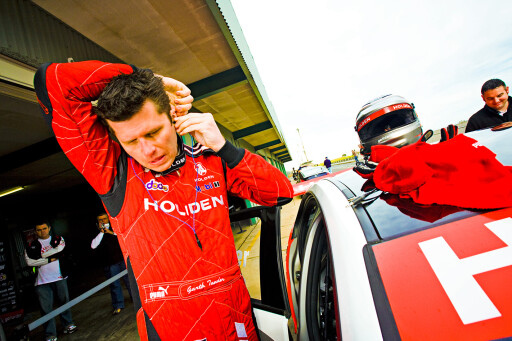 We roll slowly out into pitlane, with a distinct lack of macho burnouts down the length of the pits, and Tander takes a careful glance over his left shoulder as we exit. It’s 8am and the circuit is empty, but checking the track’s clear when you’re leaving pit lane is a kind of unwritten law.
We roll slowly out into pitlane, with a distinct lack of macho burnouts down the length of the pits, and Tander takes a careful glance over his left shoulder as we exit. It’s 8am and the circuit is empty, but checking the track’s clear when you’re leaving pit lane is a kind of unwritten law.
He gently tickles the throttle and coasts through the kink and down towards Turn Two. He washes barely any speed off as he turns in and accelerates greedily toward the bridge’s underpass. At around the 100m mark, Tander brakes firmly and gently rolls off the brake as he caresses the nose to the apex of Speedbowl.

We’re gradually building speed with every corner that we encounter, and Tander’s confidence in the car beneath him rises at a similar rate. Just before we crest the bridge, he momentarily settles the car with the brakes. But as we pop over the crest at the peak of the bridge, already committed to the fast right-hander leading off the bridge and onto the Grand Prix circuit, we see the tyres.
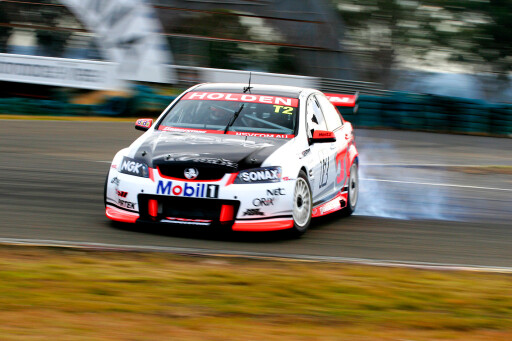 Instantly, I think to myself, ‘We’ve only got the South Circuit!’ But, having raced here only once every year and always on the full Grand Prix Circuit, Tander isn’t aware that the full circuit’s closed.
Instantly, I think to myself, ‘We’ve only got the South Circuit!’ But, having raced here only once every year and always on the full Grand Prix Circuit, Tander isn’t aware that the full circuit’s closed.
No-one’s mentioned it to him – or anyone else for that matter – and we’re heading straight towards the rubber wall at over highway speeds. And they’re less than 30 metres away. The silence is piercing in the cabin. I know there’s no way we’re going to stop in time and I brace myself against the door handle.
Tander hardly reacts – I mean he jumps on the middle pedal withe the speed of a sprinter and strength of a weightlifter, but he barely even draws in breath as we rush headlong at the tyres. No panic, no unsettling the car by swerving, except for a small steer to the right only a few metres before the tyre wall, when he realises impact is unavoidable.
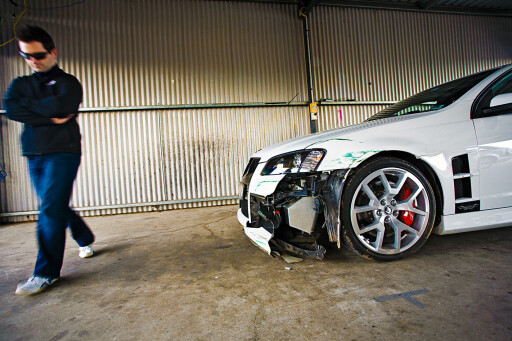 Impact is soft, really. We wouldn’t even be doing 20km/h, and we only move the tyre wall back two metres. Still without voice, and sure that neither him or I are hurt, Tander leaps from the car to survey the damage. With a few blurted expletives, he realises that he’s stacked HSV’s prized supercar.
Impact is soft, really. We wouldn’t even be doing 20km/h, and we only move the tyre wall back two metres. Still without voice, and sure that neither him or I are hurt, Tander leaps from the car to survey the damage. With a few blurted expletives, he realises that he’s stacked HSV’s prized supercar.
There’s no spoilt brat performance, no attempt to remove himself from blame, just a sheepish look as he hands part of the broken front spoiler to HSV’s PR man, who was only about ten car-lengths behind us, watching the whole event unfold.
Now there’s irony for you. But that’s not why we’re here. So after a few running repairs (!), we’re pitching the W427 up against the V8Supercar. Okay, a race car and a road car sounds unfair at first, but when they’re both driven side-by-side, the difference isn’t as great as you might expect.
 They’re obviously based on the same VE Commodore underneath, and they’re not that far apart on the spec sheet. “In terms of actual power, if you put one of those W427 engines in the front of a V8 Supercar driveline, you probably wouldn’t feel a huge amount of difference,” says Tander.
They’re obviously based on the same VE Commodore underneath, and they’re not that far apart on the spec sheet. “In terms of actual power, if you put one of those W427 engines in the front of a V8 Supercar driveline, you probably wouldn’t feel a huge amount of difference,” says Tander.
“The power’s very comparable.” His view is reiterated by the numbers. The V8 Supercar’s race-tuned 5.0-litre V8 pumps out 462kW @ 6950rpm and 630Nm @ 5250rpm, while the 7.0-litre LS7 W427 engine delivers 375kW @ 6500rpm and a stump-pulling 640Nm @ 5000rpm.
It might be 87kW down in peak power, but the LS7 has a broad spread of torque right across its rev range and isn’t as peaky in its delivery as the V8 Supercar’s engine. At first, the experience of both from inside the cars is quite different.
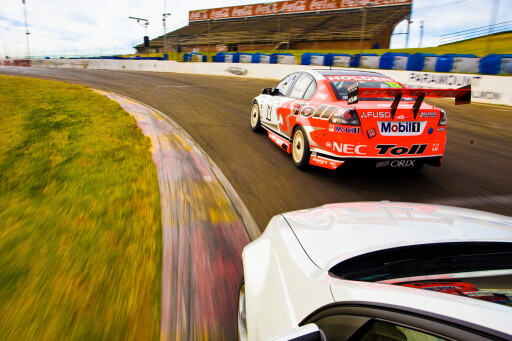 When Seton fired up the V8 Supercar after myself and photographer Wielecki were safely strapped in, the big V8 came to life in an explosion of sound. Trickling down pitlane at pedestrian speeds, you can hear the drivetrain whining and feel it shunting beneath you.
When Seton fired up the V8 Supercar after myself and photographer Wielecki were safely strapped in, the big V8 came to life in an explosion of sound. Trickling down pitlane at pedestrian speeds, you can hear the drivetrain whining and feel it shunting beneath you.
The car lurches angrily, like a pitbull pulling at its lead. But when we’re free of the pits, the V8 Supercar leaps forward and fires at the racetrack. Seton is busy at the steering wheel as we head down into Suttons, almost uncomfortably as he tries to keep control of his raging beast.
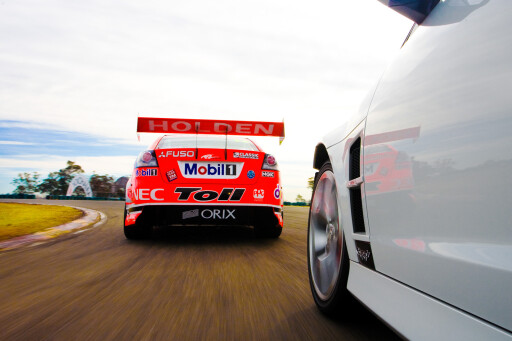 It has plenty of power, but that’s not the first thing you notice. The brakes are nothing short of phenomenal, even in comparison with the W427’s huge stoppers. And while the V8 Supercar has plenty of lateral grip, its drive off the corners is the most startling of its abilties.
It has plenty of power, but that’s not the first thing you notice. The brakes are nothing short of phenomenal, even in comparison with the W427’s huge stoppers. And while the V8 Supercar has plenty of lateral grip, its drive off the corners is the most startling of its abilties.
The W427 is also strong in that area. “It’s got really good traction grip,” says Tander. “You can’t actually hoon it up and get it sideways because of the amount of generic grip the car’s got – even with ESP off.” Power is another area where the W427 impresses, and alarmingly, it’s under acceleration down the main straight that it feels closest to the V8 Supercar.
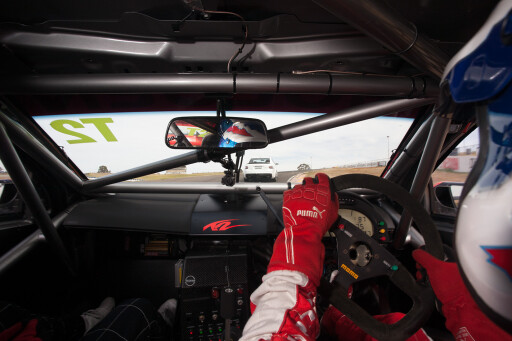 “The speed down the main straight of the South Circuit reached just over 200km/h on one lap – the V8 Supercar doesn’t go much faster!” says Tander. The W427 sounds much more refined and quieter than the race car, as you’d expect, but there’s something about the the deep bellow of 7.0-litres worth of Chev muscle that even the V8 Supercar can’t match.
“The speed down the main straight of the South Circuit reached just over 200km/h on one lap – the V8 Supercar doesn’t go much faster!” says Tander. The W427 sounds much more refined and quieter than the race car, as you’d expect, but there’s something about the the deep bellow of 7.0-litres worth of Chev muscle that even the V8 Supercar can’t match.
In comparison with LS3 HSVs, though, there’s a marked increase in exhaust volume. Brakes are also strong in the W427, Tander surprised with both the amount of stopping power and ease of modulation. “The braking’s really good and you can play with the pedal pressure to put the nose exactly where you want to.
Even into Suttons, you’re hard on the throttle and then deep on the brakes and you can get the whole car to come down onto the suspension with the brake pedal and not worry about the rear stepping out.” But we’re not convinced the W427 is totally rid of the rear axle tramp under braking that afflicts other VEs, after taking it for a brief spin ourselves.
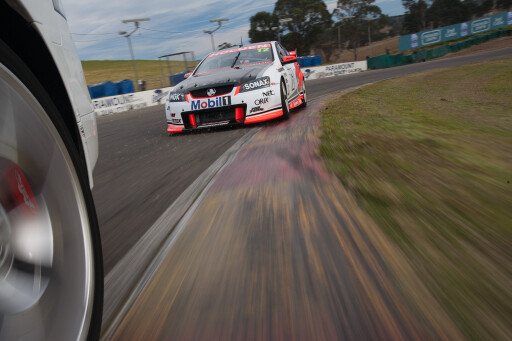 We’ll reserve our judgement until its appearance in the PC08 Final, though. But in terms of our comparison, how does the W427 rate against the Supercar? Shockingly well, actually. “I’ve heard reports saying that the W427 has the grunt of a V8 Supercar ten years ago,” says Tander, “and in terms of power and braking performance, they’d probably be correct.”
We’ll reserve our judgement until its appearance in the PC08 Final, though. But in terms of our comparison, how does the W427 rate against the Supercar? Shockingly well, actually. “I’ve heard reports saying that the W427 has the grunt of a V8 Supercar ten years ago,” says Tander, “and in terms of power and braking performance, they’d probably be correct.”
“I reckon you could put it in a production car race with just a set of slicks on and it’d probably blow most of them away, I’d imagine.”
The W427 is comparable in almost every way with the V8 Supercar. Noise, sheer grunt, chassis balance, strong drive and traction, braking performance and it’s probably not that far off the Supercar in laptime.
 We reckon the W427 would only be about six seconds slower than the V8 Supercar around the South Circuit’s 50-second lap. That’s hugely impressive for any road car. Of course, there will be those who continue to rubbish the W427 as a $155,500 Commodore.
We reckon the W427 would only be about six seconds slower than the V8 Supercar around the South Circuit’s 50-second lap. That’s hugely impressive for any road car. Of course, there will be those who continue to rubbish the W427 as a $155,500 Commodore.
But that’s a cold view to take of a car that represents the pinnacle of Australian performance car engineering. And after driving both around Oran Park side-by-side, we’d prefer to take the view that the W427 is a road-going version of V8 Supercar. For $300,000 less.
SPECS
| HSV V8 Supercar | HSV W427 | |
| Engine | 90-degree V8, OHV, 16v | 90-degree V8, OHV, 16v |
| Power | 462kW @ 6950rpm (approx) | 375kW @ 6500rpm |
| Torque | 630Nm @ 5250rpm (approx) | 640Nm @ 5000rpm |
| Kerb Weight | 1355kg | 1874kg |
| 0-100km/h | 3.6sec (claimed) | 4.8sec |
| Transmission | 6-speed sequential Holinger dog-box | 6-speed manual |
| Tyres | Dunlop Control Slicks | Bridgestone Potenza RE050A |
| Price | $450,000 | $155,500 |

COMMENTS